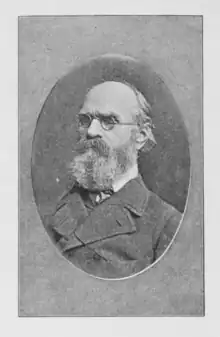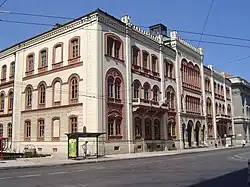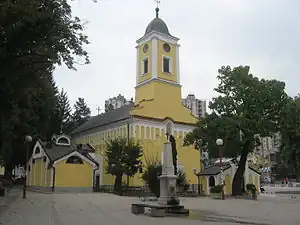Jan Nevole
Jan Nevole (15 April 1812 – 12 April 1903) was an Austro-Hungarian architect, active in Prague and mostly in Belgrade. He was a proponent of the Rundbogen style.[1]

Life
Nevole was born on 15 April 1812 in Víska in the Cáslav region of the Austrian Empire. He attended the national school in Jihlava, then at a one-year school in Pardubice, the Academy of Fine Arts in Vienna (where, in addition to good technical skills, he also received an education in art), and finally at the Prague Polytechnic in 1826.[2]
Early career
He started his career as an architect in Prague, where he worked in the Construction Directorate for four years, and then he collaborated with the builder Hošek in the design of the public bath St. Wenceslas Spa, graduating from the Polytechnic (1930), he returned, participated in the construction of the Prague State Railway Station and built Helmingr's villa at the then Žitné brány.[1]
Arrival in Serbia
After the stabilization of state conditions after the change of the dynasty, in 1843, an advertisement was published in Srpske novine in which "engineers" were sought. It is not known who applied or who was accepted, but after that announcement, the number of arrivals of engineers and architects in Belgrade was noticeably higher. Among them were two persons, perhaps the most important for the development of construction in Serbia in the period that followed: Jan Nevole and Emilijan Josimovic.
When Janko Šafarik came to Prague with the task of bringing an engineer to Serbia who would manage construction there, he heard the most recommendations for Jan Nevole. He offered him the position of chief engineer and 800 thalers a year, to which Nevole agreed, regardless of his enviable reputation in Prague, and came to Belgrade in 1845 with his young wife. Here he built the family home and bought a vineyard in Mokri Lug. In Belgrade, Nevole got a job in the Ministry of Public Works, where the name of the architect was used for the first time, which sets Nevole apart from other state engineers. At the Engineering School in Topcider, the first institution (founded in 1846) of higher learning in the field of construction, Nevole taught drawing. In 1851, on his initiative to improve the state construction service and education, the Department of Construction was established at the Ministry of the Interior. In addition to the architect Nevole, the chief engineer, engineers August Cerman, Nikola Jovanovic, Jovan Ristic and Aksentije Markovic also worked in this department. In 1858, Nevole left the civil service due to dynastic changes and began working in Belgrade as a private builder.[3][4]
Jan Nevole may not be the earliest modern architect to have ever worked in Serbia, but in retrospect, it was the Serbian government that invited him and others "to conduct reforms, used for the university to mark the beginning of national rebirth".[5] Combining German Rundbogen and Serbo-Byzantine Revival styles, Captain Miša's Mansion (??????? ?????? ?????), a private residence of monumental scale, completed in 1863, became the first major work of that movement.[6][7] At the time, it was the largest and most beautiful palace in Serbia.[8] Although 21st-century taste may differ, it was nonetheless authentic in both form and detail and, considered in the context of its own time, a spectacular achievement. During his time in Serbia from 1845 until 1863, Nevole designed many buildings, the vast majority there.
In 1862, architect František Šebek, Nevole's brother-in-law and the owner of a large estate in Svobodné Hamry, died and left Nevole's wife the farm. Nevole retired and moved into the inheritance there the following year, and they became farmers for the rest of their lives. They also owned the Drevíkov farm.[8]
Throughout his life, Nevole was active in patriotic circles wherever he went and worked. In Prague, he met other revivalists and supported the emerging Czech literature; Josef Kajetán Tyl dedicated a short story – "Rozin Ruthardov" – to him about the ancient builder. In Belgrade, Nevole's house was the center of the local Czech community in Serbia. There he befriended Serbian General František Zach, who then, after retiring due to disability, lived with the Nevole household in Bohemia for several years. Nevole also gained the respect of citizens with his patriotic deeds in Kamenice in Old Serbia, where he last worked on construction projects.[9]
He died of old age on 12 April 1903, in Svobodné Hamry, Austria-Hungary.[9]
Oeuvre
There is no precise data on all the buildings in the construction of which Novele participated, but they were certainly numerous. Among them are:
- Military hospital at Njegoševa 15 in Belgrade, demolished due to the construction of the Third Belgrade Gymnasium,
- The Military Academy in Belgrade, on the corner of Kneza Milos and Nemanjina, destroyed on the 6th of April 1941 Nazi bombing of Belgrade,
- Old spa in Sokobanja,
- Captain Miša's zdanje (bequest) is today a cultural monument of exceptional importance,[10] Miša Anastasijevic specifically chose Jan Nevole, educated abroad in the Rundebogenstil, to employ the forms commonly connected with medievalism.[1] Familiarity with such monuments in Vienna, Karlsruhe or Berlin in the hands of European emigrant architects in Belgrade and other major mid-19th-century Serbian architects brought fundamental theoretical change which the style underwent in Serbia in both these two groups that became a distinct Serbian "round-arched style", albeit in the spirit of Serbo-Byzantine Revival.
- Church of St. George in Užice.
- One of the first buildings that Jan Navole designed was the new Military Hospital in Vracar, constructed between 1846 and 1849, intended to accommodate 120 patients.
- The other important state building he designed was the Artillery School, ie the Military Academy. The building was built around 1850 on the road to Topcider, in today's Njegoševa Street.[11][12]
When Nevole left the civil service in 1858 and started working as a private builder (but before leaving Serbia in 1863), he designed his most significant and monumental work: Captain Miša's Mansion. Captain Miša Anastasijevic was a private investor, then the richest Serbian trader and shipping magnate. Built from 1858 to 1863, it was the largest and most opulent palace in Serbia. It was intended for the court of an untried ruling couple: the daughter of Anastasijevic, Sara and Ðorde Karadordevic (1827–1889). Ambitious plans for marriage were ruined by the return of Prince Miloš Obrenovic to power, so Anastasijevic bequeathed the building to the "fatherland" for the accommodation of various cultural and educational institutions.
The architecture of the building is a stylistic mixture of Gothic, Romanesque and Renaissance elements with decorative facades. On the façade towards the University Park, there are sculptures of Apollo with lyre (right) and Minerva with spear and shield (left). The building was always light in colour with reddish decorations.
Spa renovation in Serbia
The poor condition in the spas and lack of accommodation was significantly improved by the respective collaborative efforts of doctor Emmerich P. Lindenmayer (1806–1883), chief of the Serbian Medical Corps, and the architect Jan Nevola.
Gallery
 Captain Miša's Mansion
Captain Miša's Mansion St. George Serbian Orthodox Church, Užice
St. George Serbian Orthodox Church, Užice Spas in Sokobanja
Spas in Sokobanja Grave of Jan Nevole
Grave of Jan Nevole
Kinship
Among Jan Nevole's relatives, the following became famous:
- His brother-in-law (brother of his wife) František Šebek (1814–1862), was an architect and politician active in Vienna[13]
- His son Dr. Milan Nevole (1846–1907) was a chemist, sugar expert, businessman and professional writer[13]
- Son-in-law Karel Preis (1846–1916), husband of his daughter Anna, was a professor of chemistry[14][15]
References
- Tanja D. Conley (25 February 2020). Urban Architectures in Interwar Yugoslavia. Taylor & Francis. p. 43. ISBN 978-0-429-68645-0. Retrieved 10 April 2021.
- Gabler, Vilém (1892-04-08). "Jan Nevole". Světozor. 26 (21): 250. Retrieved 31 May 2014.
- Ciric, Sonja (February 25, 2010). "Ideje novog grada". Vreme. 999. Retrieved 8 May 2020.
- "Jan Nevole". ceskatelevize.cz. Retrieved 7 May 2020.
- Klusáková, Luda (2004). "We" & "the Others": Modern European Societies in Search of Identity: Studies in Comparative History. ISBN 9788024607863.
- Makas, Emily Gunzburger; Conley, Tanja Damljanovic (4 December 2009). Capital Cities in the Aftermath of Empires: Planning in Central and Southeastern Europe. ISBN 9781135167257.
- Podle prání investora mela tato budova sloužit kulturním a vzdelávacím úcelum; dnes v ní sídlí rektorát Belehradské univerzity. Viz Captain Miša Building na mit.edu.
- "Famous Buildings 1 na". Beograd.rs. Retrieved 1 December 2020.
- "KRAMERIUS - PERIODICAL (796/5736010) - N (64/1099331) - Národní listy (1/308066)". National Library of the Czech Republic. Retrieved 2014-05-31.
- "Captain Miša's Edifice". Retrieved 8 May 2020.
- Kovacevic, Predrag. "Ko je projektovao užicku Sabornu crkvu Sv.Ðorda?". uzicanstveno.rs. Retrieved 7 May 2020.
- Roter-Blagojevic, Mirjana. "Jan Nevole, prvi moderni arhitekta u Beogradu". researchgate.net. Retrieved 7 May 2020.
- "Šebek, František, 1814-1862" (in Czech). Central Bohemian Scientific Library in Kladno. Archived from the original on 2014-05-31.
- "Jan Nevole". Národní listy. 43 (103): 7. 1903-04-15. Retrieved 2014-05-31.
- "KRAMERIUS - PERIODICAL (796/5736010) - N (64/1099331) - Národní listy (1/308066)". National Library of the Czech Republic. Retrieved 31 May 2014.